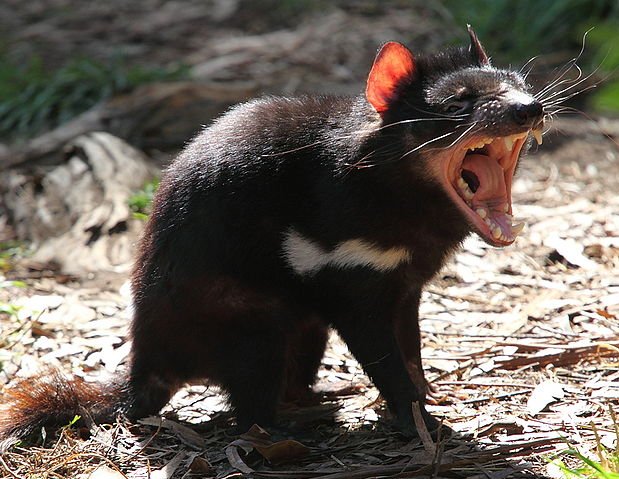Completed genome is first step to tackling Tasmanian devil facial tumours

Researchers from the Wellcome Trust Sanger Institute and Illumina have used next generation sequencing technology to create a draft genome sequence for the endangered Tasmanian devil and will use this to find genetic mutations in the transmissible cancer that is ravaging its population.
The results open the door for new research to pick out those specific mutations that drive the cancer and will lay the foundation for ongoing work to trace the spread of disease and inform the development of preclinical tests, conservation strategies and disease therapies. The announcement is made today by Sanger Institute researcher, Dr Elizabeth Murchison, at the AMATA 2010 Conference in Hobart, Tasmania.
The Tasmanian devil is the largest carnivorous marsupial and is native to the island of Tasmania. The species is at risk of extinction in the wild due to a transmissible facial cancer, which is spread between devils by the transfer of cancer cells by biting. The cancerous cells from the first devil then colonise the bitten animal, which usually dies within months of the appearance of symptoms. In the 14 years since the disease was first observed, the devil population has declined by more than 80 per cent.
Tasmanian devil facial tumour is almost unique in cancers of the animal kingdom in that it is transmitted by direct transplantation of cancer cells from animal to animal.
“This sequence is invaluable and comes at a crucial time. By comparing our draft sequence with samples taken from many hundreds of devils suffering from this cancer, we can begin to look at the spread of the disease, quite literally, by identifying geographical routes and barriers in its transmission. This knowledge could ultimately shape the ongoing conservation efforts in Tasmania.
“It took 10 years to sequence the draft human genome; the devil took just two months using this new technology. We are entering a new era where genome sequencing can be applied to some of our most pressing problems in real time.”
Dr Elizabeth Murchison from the Sanger Institute’s Cancer Genome Project
As well as producing the draft genome sequence for a healthy Tasmanian devil, named Salem, the team has sequenced two independent tumour samples taken from devils with the disease, which will now be analysed. This will allow the researchers to pinpoint those mutations that are present only in the cancerous samples.
The next step will be to sequence many more Tasmanian devil facial tumour samples. By generating profiles of the mutations present in these cancers, the team hopes to improve understanding of the disease and its spread.
“This sequence is not only a boon to the efforts to protect this endangered species. We believe that this research, the first of its kind to look at this very unusual form of transmissible cancer, will also teach us important lessons about the evolution of cancers. What we are observing is not just a class of cancer that afflicts the Tasmanian devil; we are actually peering into the very same cancer that originated in just one devil, some 20 years ago – a cancer that has long survived its original host.
“In research terms, this is truly unique – it will provide an unprecedented window into the evolution of cancer.”
Professor Mike Stratton Director of the Sanger Institute and joint head of the Cancer Genome Project
Sequencing, de novo assembly and analysis of genetic variation of the three genomes has been undertaken jointly by scientists at the Sanger Institute and Illumina.
“We’re excited about what this project means not just to the future of this very rare and endangered species and this unusual cancer. It is wonderful to see our sequencing platform opening a world of new possibilities for scientists to get at the root causes and manifestations of disease through close collaborations like this.”
David Bentley Chief Scientist at Illumina
More information
Selected websites
About Illumina
Illumina is a leading developer, manufacturer, and marketer of life science tools and integrated systems for large-scale analysis of genetic variation and function. We provide innovative sequencing and array-based solutions for genotyping, copy number variation analysis, methylation studies, gene expression profiling, and low-multiplex analysis of DNA, RNA and protein. We also provide tools and services that are fueling advances in consumer genomics and diagnostics. Our technology and products accelerate genetic analysis research and its application, paving the way for molecular medicine and ultimately transforming healthcare.
The Wellcome Trust Sanger Institute
The Wellcome Trust Sanger Institute, which receives the majority of its funding from the Wellcome Trust, was founded in 1992. The Institute is responsible for the completion of the sequence of approximately one-third of the human genome as well as genomes of model organisms and more than 90 pathogen genomes. In October 2006, new funding was awarded by the Wellcome Trust to exploit the wealth of genome data now available to answer important questions about health and disease.
The Wellcome Trust
The Wellcome Trust is a global charitable foundation dedicated to achieving extraordinary improvements in human and animal health. We support the brightest minds in biomedical research and the medical humanities. Our breadth of support includes public engagement, education and the application of research to improve health. We are independent of both political and commercial interests.


